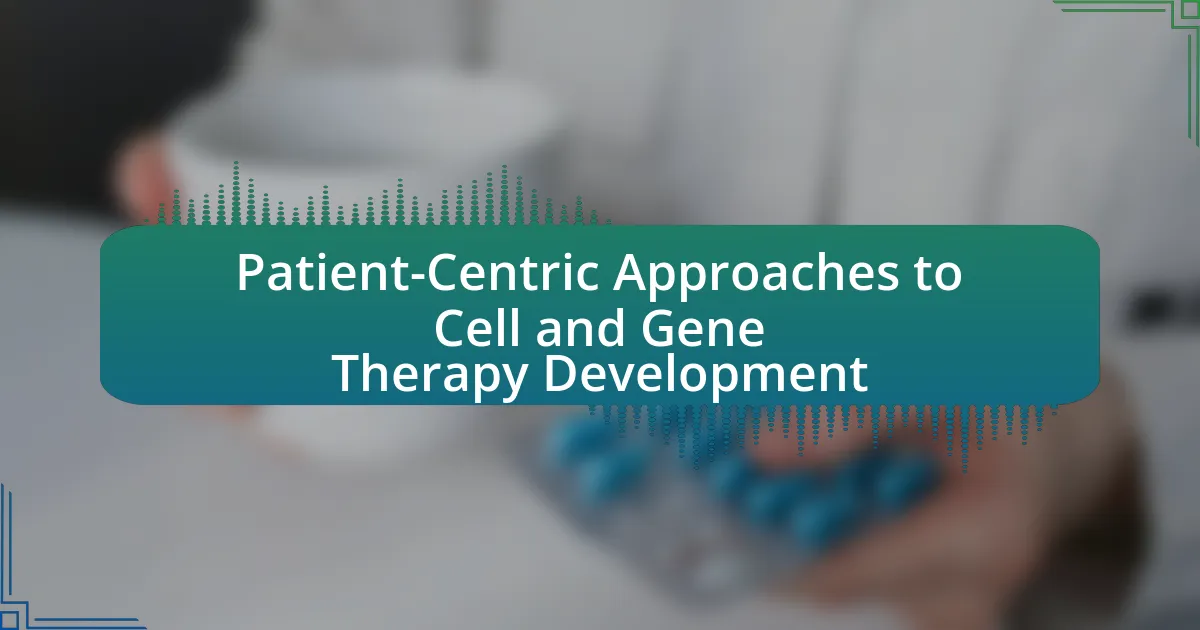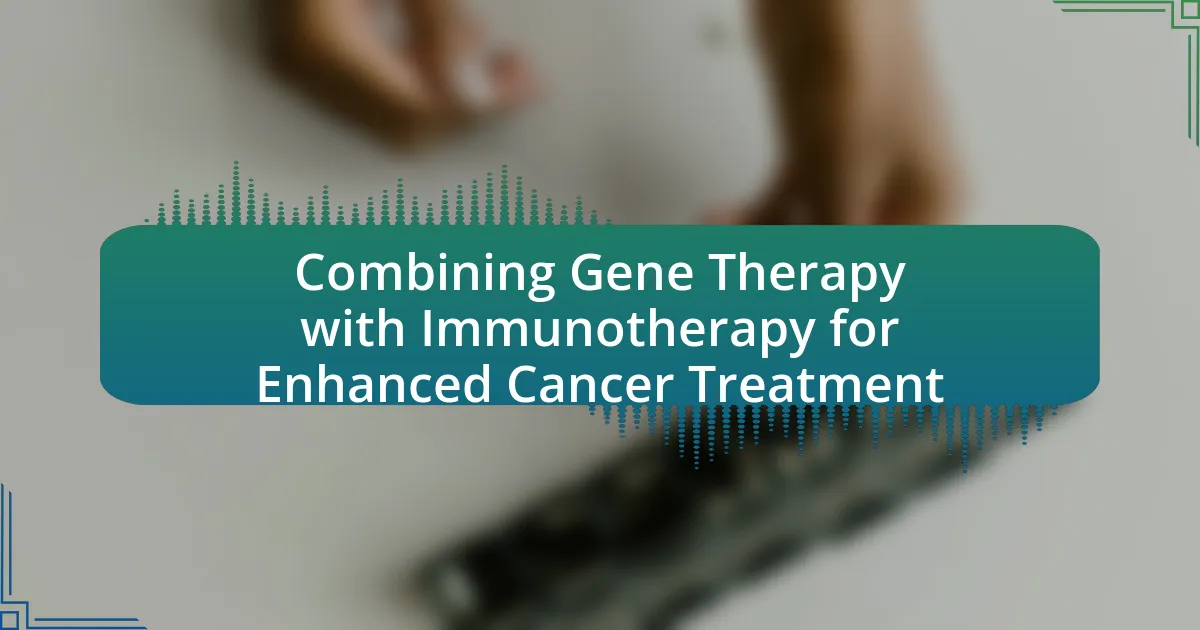The article focuses on the future trends in cell therapy, highlighting advancements in gene editing technologies, particularly CRISPR, and the rise of allogeneic cell therapies that enhance accessibility and reduce costs. It discusses the evolution of personalized medicine, improved delivery methods, and the adaptation of regulatory frameworks to support innovative therapies. Key anticipated applications include regenerative medicine, cancer treatment, and autoimmune disease management, with a focus on overcoming challenges such as high costs and manufacturing complexities. The role of collaborations, funding, and technological innovations in shaping the future of cell therapy is also examined, emphasizing the potential impact on patient outcomes and treatment personalization.
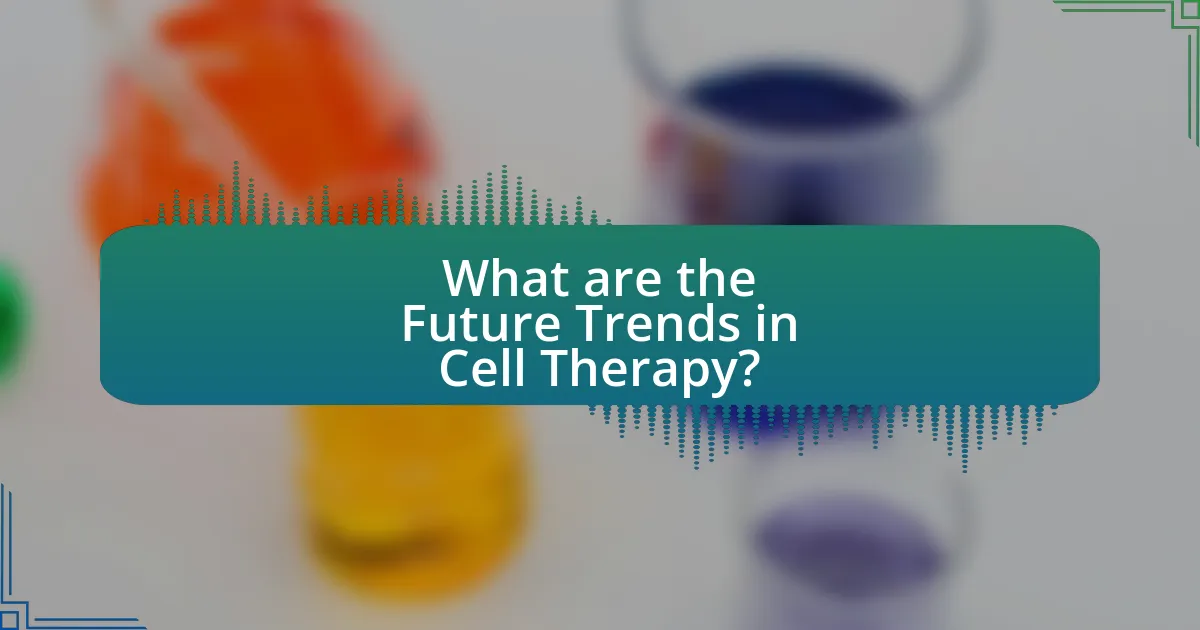
What are the Future Trends in Cell Therapy?
Future trends in cell therapy include advancements in gene editing technologies, such as CRISPR, which enhance the precision of therapeutic applications. Additionally, the development of allogeneic cell therapies, which utilize donor cells, is expected to increase accessibility and reduce costs. Research is also focusing on the integration of artificial intelligence to optimize treatment protocols and patient outcomes. Furthermore, the expansion of personalized medicine, where therapies are tailored to individual genetic profiles, is anticipated to improve efficacy. These trends are supported by ongoing clinical trials and increasing investment in regenerative medicine, indicating a robust growth trajectory for cell therapy in the coming decade.
How is cell therapy evolving in the next decade?
Cell therapy is evolving in the next decade through advancements in personalized medicine, enhanced delivery methods, and improved regulatory frameworks. Personalized medicine will allow for tailored therapies based on individual genetic profiles, increasing efficacy and reducing adverse effects. Enhanced delivery methods, such as the use of nanoparticles and improved scaffolding techniques, will facilitate more effective targeting of therapies to specific tissues or cells. Additionally, regulatory frameworks are becoming more streamlined, enabling faster approval processes for innovative therapies. These trends are supported by ongoing research and clinical trials demonstrating the potential of cell therapies in treating various diseases, including cancer and genetic disorders.
What technological advancements are driving changes in cell therapy?
Technological advancements driving changes in cell therapy include gene editing techniques, such as CRISPR-Cas9, and improvements in cell manufacturing processes. CRISPR-Cas9 allows for precise modifications of genetic material, enhancing the efficacy and safety of therapies targeting genetic disorders. Additionally, advancements in bioprocessing technologies, such as automated cell culture systems and scalable production methods, enable the efficient generation of large quantities of therapeutic cells. These innovations are supported by data indicating that CRISPR has been used in over 1,000 clinical trials, demonstrating its significant impact on the field.
How will regulatory frameworks adapt to new cell therapy innovations?
Regulatory frameworks will adapt to new cell therapy innovations by implementing more flexible and expedited approval processes. This adaptation is necessary to keep pace with rapid advancements in cell therapies, such as CAR-T cell treatments, which have shown significant efficacy in treating certain cancers. Regulatory bodies like the FDA have already begun to establish pathways, such as the Regenerative Medicine Advanced Therapy (RMAT) designation, which facilitates faster development and review of regenerative medicine products. These frameworks will increasingly incorporate real-world evidence and post-market surveillance to ensure safety and efficacy while promoting innovation.
What are the anticipated applications of cell therapy in the future?
Anticipated applications of cell therapy in the future include regenerative medicine, cancer treatment, and autoimmune disease management. Regenerative medicine aims to repair or replace damaged tissues and organs using stem cells, which have shown promise in clinical trials for conditions like heart disease and spinal cord injuries. In cancer treatment, cell therapies such as CAR-T cell therapy are being developed to enhance the immune system’s ability to target and destroy cancer cells, with ongoing research indicating improved patient outcomes. Additionally, cell therapy is expected to play a significant role in managing autoimmune diseases by reprogramming immune cells to reduce their attack on the body’s tissues, as evidenced by studies demonstrating the efficacy of regulatory T cells in conditions like Type 1 diabetes.
Which diseases are expected to benefit most from advancements in cell therapy?
Advancements in cell therapy are expected to benefit diseases such as cancer, autoimmune disorders, and neurodegenerative diseases. Specifically, hematological cancers like leukemia and lymphoma have shown promising results with CAR T-cell therapies, which have led to significant remission rates in patients. Additionally, autoimmune diseases such as multiple sclerosis and rheumatoid arthritis are being targeted through regenerative approaches that utilize stem cells to modulate immune responses. Neurodegenerative diseases, including Parkinson’s and Alzheimer’s, are also under investigation for cell therapy applications, aiming to replace damaged neurons and restore function. These expectations are supported by ongoing clinical trials and research demonstrating the potential of cell therapies to alter disease progression and improve patient outcomes.
How will personalized medicine influence the future of cell therapy?
Personalized medicine will significantly enhance the efficacy and safety of cell therapy by tailoring treatments to individual genetic profiles and disease characteristics. This approach allows for the selection of the most suitable cell types and therapeutic strategies, improving patient outcomes. For instance, advancements in genomic sequencing enable the identification of specific mutations in cancer patients, leading to the development of targeted cell therapies that are more effective than traditional methods. Studies have shown that personalized approaches can increase response rates and reduce adverse effects, as seen in CAR T-cell therapies that are customized based on a patient’s unique tumor markers.
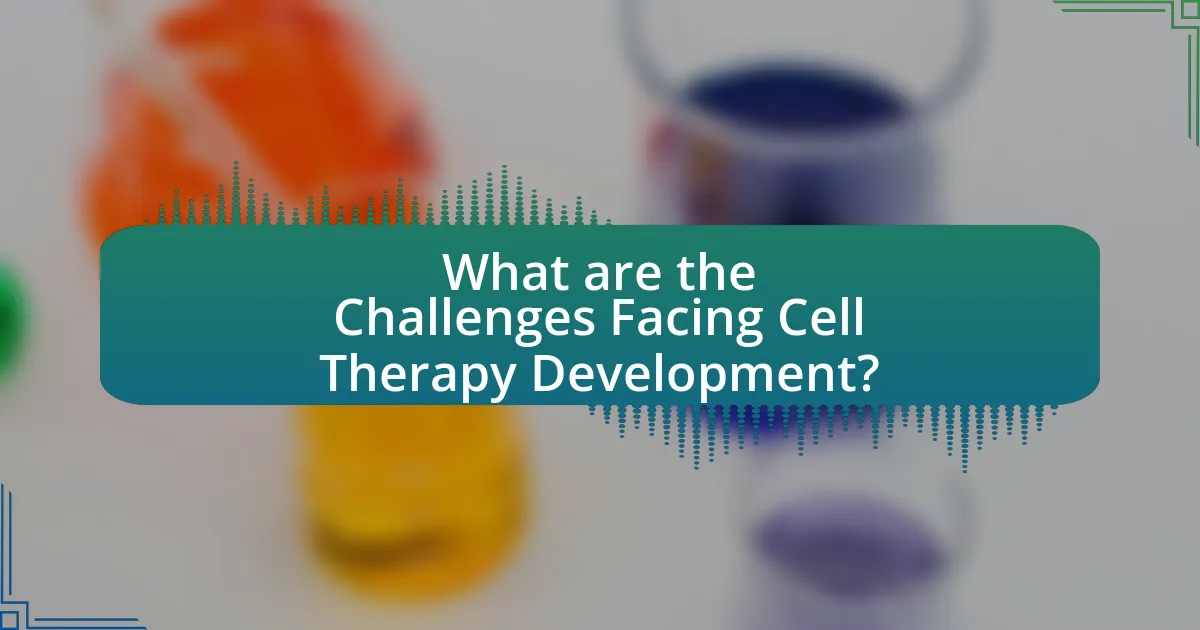
What are the Challenges Facing Cell Therapy Development?
The challenges facing cell therapy development include regulatory hurdles, manufacturing complexities, and safety concerns. Regulatory hurdles arise from the need for extensive clinical trials to demonstrate safety and efficacy, which can delay approval processes. Manufacturing complexities stem from the need for scalable production methods that maintain cell quality and functionality, as evidenced by the difficulties in producing CAR-T cells at a commercial scale. Safety concerns involve potential adverse effects, such as cytokine release syndrome and off-target effects, which necessitate rigorous monitoring and risk management strategies. These challenges collectively hinder the timely advancement of cell therapies into clinical practice.
What are the key obstacles to widespread adoption of cell therapies?
The key obstacles to widespread adoption of cell therapies include high costs, regulatory challenges, and limited availability of suitable cell sources. High costs arise from complex manufacturing processes and the need for personalized treatments, making therapies financially inaccessible for many patients. Regulatory challenges stem from stringent approval processes that can delay the introduction of new therapies to the market, as evidenced by the lengthy review times for cell-based products by agencies like the FDA. Additionally, the limited availability of suitable cell sources restricts the scalability of these therapies, as many require specific donor cells or tissues that are not readily obtainable.
How do manufacturing and scalability issues impact cell therapy?
Manufacturing and scalability issues significantly hinder the advancement of cell therapy by limiting production capacity and increasing costs. These challenges arise from the complex processes involved in cell isolation, expansion, and quality control, which can lead to variability in product quality and efficacy. For instance, the need for specialized facilities and equipment to maintain sterile conditions and the requirement for skilled personnel contribute to high operational costs. According to a report by the Alliance for Regenerative Medicine, the cost of goods sold for cell therapies can exceed $100,000 per patient, making widespread adoption difficult. Furthermore, scalability issues can delay the availability of therapies to patients, as companies struggle to meet regulatory requirements and production demands.
What ethical considerations must be addressed in cell therapy research?
Ethical considerations in cell therapy research include informed consent, the potential for exploitation of vulnerable populations, and the long-term effects of therapies. Informed consent is crucial as participants must fully understand the risks and benefits associated with experimental treatments. The exploitation of vulnerable populations, such as those with limited access to healthcare, raises concerns about equitable access and fairness in research. Additionally, the long-term effects of cell therapies are often unknown, necessitating ongoing monitoring and ethical oversight to ensure patient safety and well-being. These considerations are essential to uphold ethical standards and protect participants in cell therapy research.
How can these challenges be overcome?
To overcome challenges in cell therapy, researchers must focus on enhancing manufacturing processes, improving regulatory pathways, and increasing patient access. Streamlining manufacturing can be achieved through automation and standardized protocols, which can reduce costs and improve scalability. For regulatory pathways, collaboration with agencies like the FDA can lead to clearer guidelines and faster approvals, as seen in the expedited processes for CAR-T cell therapies. Increasing patient access involves expanding clinical trial diversity and developing cost-effective treatment options, which can be supported by initiatives like the National Institutes of Health’s All of Us Research Program, aimed at improving health outcomes across diverse populations.
What role do collaborations play in advancing cell therapy solutions?
Collaborations are essential in advancing cell therapy solutions as they facilitate the sharing of expertise, resources, and technology among various stakeholders. By bringing together academic institutions, biotechnology companies, and healthcare providers, collaborations enhance research capabilities and accelerate the development of innovative therapies. For instance, partnerships between universities and pharmaceutical companies have led to significant breakthroughs in CAR-T cell therapies, demonstrating how combined efforts can lead to faster clinical trials and improved patient outcomes. Such collaborations also enable access to diverse funding sources, which is crucial for the costly and complex nature of cell therapy research and development.
How can funding and investment shape the future of cell therapy?
Funding and investment can significantly shape the future of cell therapy by enabling research, development, and commercialization of innovative treatments. Increased financial support allows biotech companies to conduct clinical trials, which are essential for validating the efficacy and safety of new cell therapies. For instance, in 2021, global investment in cell and gene therapy reached approximately $19 billion, facilitating advancements in therapies for conditions like cancer and genetic disorders. This financial backing not only accelerates the pace of innovation but also attracts top talent and resources, ultimately leading to more effective therapies reaching the market.
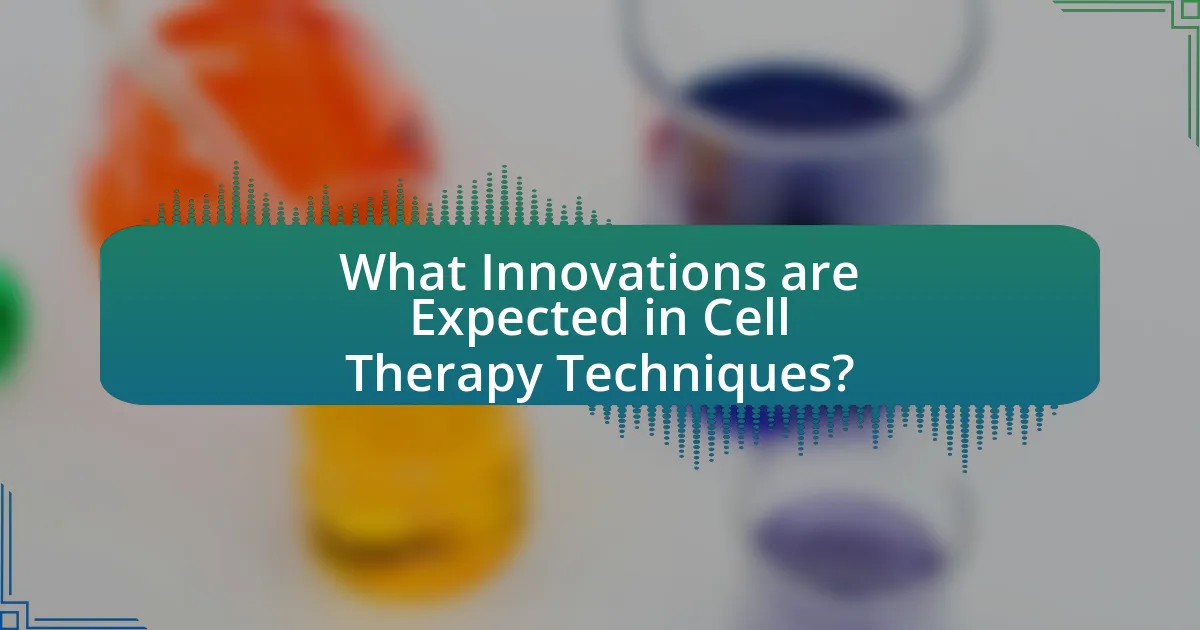
What Innovations are Expected in Cell Therapy Techniques?
Innovations expected in cell therapy techniques include advancements in gene editing, such as CRISPR-Cas9, which allows for precise modifications of genetic material to enhance therapeutic efficacy. Additionally, the development of induced pluripotent stem cells (iPSCs) is anticipated to revolutionize personalized medicine by enabling the generation of patient-specific cells for treatment. Furthermore, improvements in manufacturing processes, such as automated cell culture systems, are expected to increase scalability and reduce costs. These innovations are supported by ongoing research demonstrating enhanced safety and effectiveness in clinical trials, indicating a promising future for cell therapy.
What new methodologies are emerging in cell therapy?
New methodologies emerging in cell therapy include gene editing techniques such as CRISPR-Cas9, which allows for precise modifications of genetic material in cells to treat genetic disorders. Additionally, advancements in induced pluripotent stem cells (iPSCs) are enabling the generation of patient-specific cells for personalized therapies. Research published in “Nature Biotechnology” by Takahashi and Yamanaka highlights the potential of iPSCs in regenerative medicine. Furthermore, the integration of artificial intelligence in cell therapy development is streamlining the identification of optimal cell types and treatment protocols, as noted in a study by Zhang et al. in “Cell Reports.” These methodologies are transforming the landscape of cell therapy, enhancing efficacy and safety in treatments.
How will gene editing technologies enhance cell therapy outcomes?
Gene editing technologies will enhance cell therapy outcomes by enabling precise modifications to the genetic material of cells, thereby improving their efficacy and safety. Techniques such as CRISPR-Cas9 allow for targeted alterations that can correct genetic defects, enhance immune responses, or increase the production of therapeutic proteins. For instance, studies have shown that using CRISPR to modify T cells can significantly improve their ability to target and destroy cancer cells, leading to higher remission rates in patients. This precision reduces off-target effects and minimizes the risk of adverse reactions, ultimately leading to more successful and personalized treatment options in cell therapy.
What is the potential of stem cell research in future therapies?
Stem cell research holds significant potential for future therapies, particularly in regenerative medicine and the treatment of various diseases. This potential is evidenced by advancements in understanding how stem cells can differentiate into specialized cell types, which may lead to innovative treatments for conditions such as Parkinson’s disease, spinal cord injuries, and heart disease. For instance, a study published in the journal “Nature” by Takahashi and Yamanaka in 2006 demonstrated that induced pluripotent stem cells (iPSCs) could be generated from adult cells, providing a pathway for personalized medicine and disease modeling. Furthermore, ongoing clinical trials are exploring the use of stem cells in therapies for diabetes and age-related macular degeneration, showcasing their versatility and promise in addressing unmet medical needs.
How will data and artificial intelligence influence cell therapy?
Data and artificial intelligence will significantly enhance cell therapy by enabling personalized treatment strategies and improving the efficiency of clinical trials. AI algorithms can analyze vast datasets from genomic, proteomic, and clinical sources to identify patient-specific biomarkers, leading to tailored therapies that increase efficacy and reduce adverse effects. For instance, a study published in Nature Biotechnology demonstrated that machine learning models could predict patient responses to CAR-T cell therapy with over 80% accuracy, showcasing the potential of AI in optimizing treatment plans. Additionally, AI can streamline the design and execution of clinical trials by identifying suitable patient populations and predicting outcomes, thus accelerating the development of new cell therapies.
What role does big data play in optimizing cell therapy treatments?
Big data plays a crucial role in optimizing cell therapy treatments by enabling the analysis of vast amounts of patient data to identify patterns and improve treatment outcomes. By leveraging machine learning algorithms and predictive analytics, researchers can analyze genomic, proteomic, and clinical data to tailor therapies to individual patient profiles, enhancing efficacy and minimizing adverse effects. For instance, a study published in “Nature Biotechnology” by Zhang et al. (2020) demonstrated that big data analytics could predict patient responses to CAR-T cell therapies, leading to more personalized treatment plans. This data-driven approach not only accelerates the development of new therapies but also enhances the precision of existing treatments, ultimately improving patient care in the field of cell therapy.
How can AI improve patient selection and treatment personalization?
AI can improve patient selection and treatment personalization by analyzing vast datasets to identify patterns and predict individual responses to therapies. Machine learning algorithms can evaluate genetic, clinical, and demographic data to stratify patients based on their likelihood of benefiting from specific treatments. For instance, a study published in the journal Nature Medicine demonstrated that AI models could predict treatment outcomes in cancer patients with over 80% accuracy by integrating genomic data and clinical histories. This capability allows healthcare providers to tailor therapies to the unique characteristics of each patient, enhancing efficacy and minimizing adverse effects.
What practical steps can stakeholders take to prepare for the future of cell therapy?
Stakeholders can prepare for the future of cell therapy by investing in research and development to enhance therapeutic efficacy and safety. This includes funding clinical trials that explore innovative applications of cell therapies, such as CAR-T cell therapy for various cancers, which has shown significant success in treating previously untreatable conditions. Additionally, stakeholders should establish partnerships with academic institutions and biotech companies to foster collaboration and knowledge sharing, as evidenced by the increasing number of joint ventures in the cell therapy sector. Furthermore, stakeholders must advocate for regulatory frameworks that support the rapid approval of new therapies while ensuring patient safety, as seen in the expedited pathways established by agencies like the FDA for breakthrough therapies. Lastly, investing in manufacturing capabilities and supply chain logistics is crucial, as the demand for personalized cell therapies continues to grow, necessitating scalable production methods.



